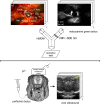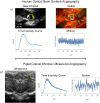Wavelet brain angiography suggests arteriovenous pulse wave phase locking
- PMID: 29140981
- PMCID: PMC5687712
- DOI: 10.1371/journal.pone.0187014
Wavelet brain angiography suggests arteriovenous pulse wave phase locking
Abstract
When a stroke volume of arterial blood arrives to the brain, the total blood volume in the bony cranium must remain constant as the proportions of arterial and venous blood vary, and by the end of the cardiac cycle an equivalent volume of venous blood must have been ejected. I hypothesize the brain to support this process by an extraluminally mediated exchange of information between its arterial and venous circulations. To test this I introduce wavelet angiography methods to resolve single moving vascular pulse waves (PWs) in the brain while simultaneously measuring brain pulse motion. The wavelet methods require angiographic data acquired at significantly faster rate than cardiac frequency. I obtained these data in humans from brain surface optical angiograms at craniotomy and in piglets from ultrasound angiograms via cranial window. I exploit angiographic time of flight to resolve arterial from venous circulation. Initial wavelet reconstruction proved unsatisfactory because of angiographic motion alias from brain pulse motion. Testing with numerically simulated cerebral angiograms enabled the development of a vascular PW cine imaging method based on cross-correlated wavelets of mixed high frequency and high temporal resolution respectively to attenuate frequency and motion alias. Applied to the human and piglet data, the method resolves individual arterial and venous PWs and finds them to be phase locked each with separate phase relations to brain pulse motion. This is consistent with arterial and venous PW coordination mediated by pulse motion and points to a testable hypothesis of a function of cerebrospinal fluid in the ventricles of the brain.
Conflict of interest statement
Figures









Similar articles
-
Angiographic Pulse Wave Coherence in the Human Brain.Front Bioeng Biotechnol. 2022 May 3;10:873530. doi: 10.3389/fbioe.2022.873530. eCollection 2022. Front Bioeng Biotechnol. 2022. PMID: 35592552 Free PMC article.
-
CSF in the ventricles of the brain behaves as a relay medium for arteriovenous pulse wave phase coupling.PLoS One. 2017 Nov 15;12(11):e0181025. doi: 10.1371/journal.pone.0181025. eCollection 2017. PLoS One. 2017. PMID: 29141045 Free PMC article.
-
Influence of systemic and cerebral vascular factors on the cerebrospinal fluid pulse waves.J Neurosurg. 1977 Jan;46(1):36-45. doi: 10.3171/jns.1977.46.1.0036. J Neurosurg. 1977. PMID: 830813
-
[A new approach for studying the retinal and choroidal circulation].Nippon Ganka Gakkai Zasshi. 2004 Dec;108(12):836-61; discussion 862. Nippon Ganka Gakkai Zasshi. 2004. PMID: 15656089 Review. Japanese.
-
[Arterial hemodynamics and pulse wave propagation].Cesk Fysiol. 2003 Dec;52(4):153-9. Cesk Fysiol. 2003. PMID: 15027148 Review. Czech.
Cited by
-
Exon prediction based on multiscale products of a genomic-inspired multiscale bilateral filtering.PLoS One. 2019 Mar 21;14(3):e0205050. doi: 10.1371/journal.pone.0205050. eCollection 2019. PLoS One. 2019. PMID: 30897105 Free PMC article.
-
Angiographic Pulse Wave Coherence in the Human Brain.Front Bioeng Biotechnol. 2022 May 3;10:873530. doi: 10.3389/fbioe.2022.873530. eCollection 2022. Front Bioeng Biotechnol. 2022. PMID: 35592552 Free PMC article.
-
CSF in the ventricles of the brain behaves as a relay medium for arteriovenous pulse wave phase coupling.PLoS One. 2017 Nov 15;12(11):e0181025. doi: 10.1371/journal.pone.0181025. eCollection 2017. PLoS One. 2017. PMID: 29141045 Free PMC article.
References
-
- Wilson MH. Monro-Kellie 2.0: The dynamic vascular and venous pathophysiological components of intracranial pressure. Journal of Cerebral Blood Flow & Metabolism. 2016;36(8):1338–1350. doi: 10.1177/0271678X16648711 - DOI - PMC - PubMed
-
- Tomita M, Osada T, Schiszler I, Tomita Y, Unekawa M, Toriumi H, et al. Automated method for tracking vast numbers of FITC-labeled RBCs in microvessels of rat brain in vivo using a high-speed confocal microscope system. Microcirculation (New York, NY: 1994). 2008;15(2):163–174. doi: 10.1080/10739680701567089 - DOI - PubMed
-
- Nyqvist H. Certain topics in telegraph transmission theory. Transactions of the AIEE. 1928;47:617–644.
-
- Shannon CE. Communication in the Presence of Noise. Proceedings of the Institute of Radio Engineers. 1949;37(1):10–21.
MeSH terms
LinkOut - more resources
Full Text Sources
Other Literature Sources

